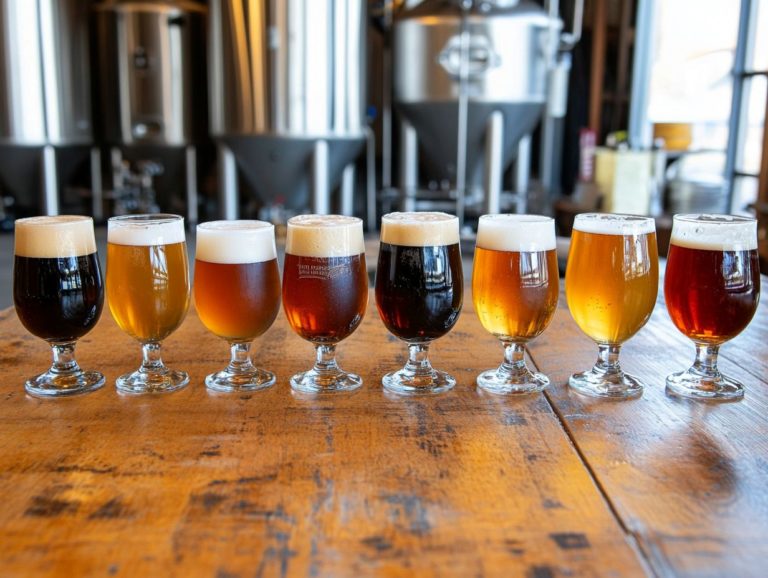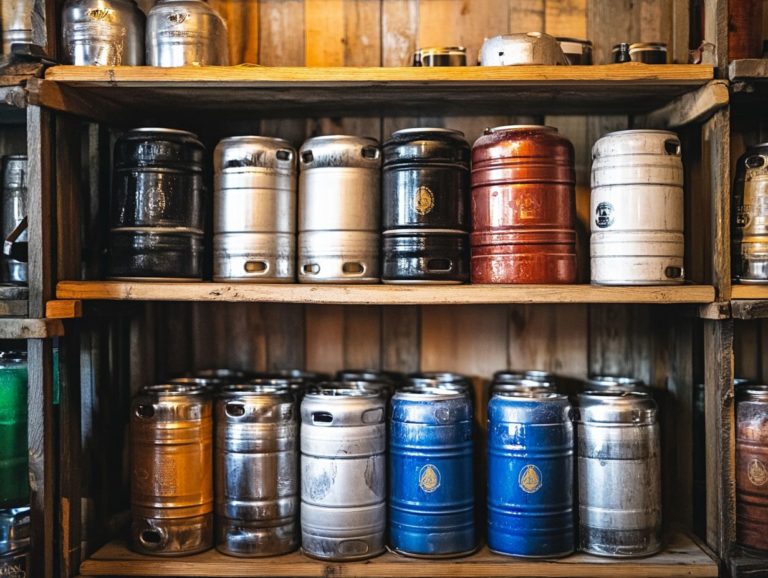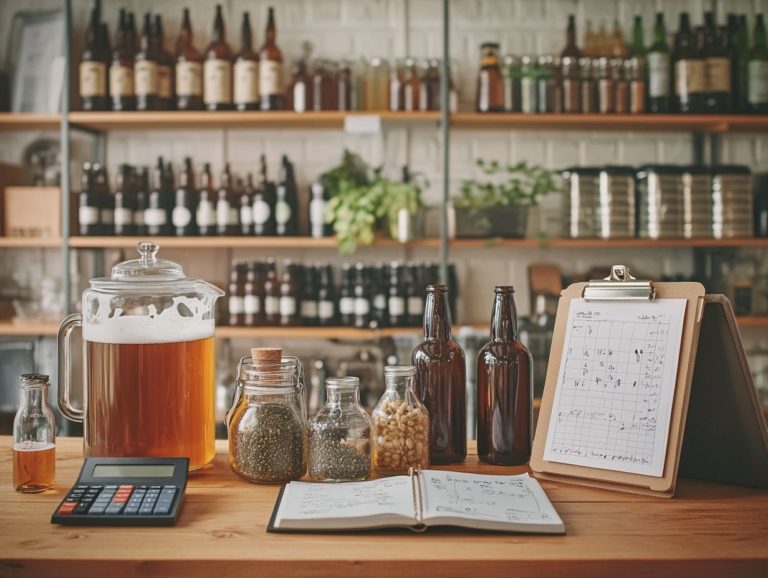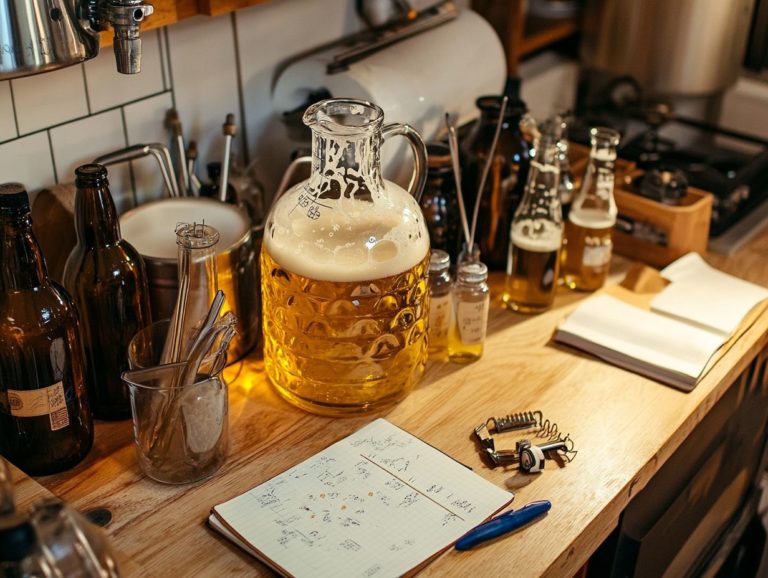What Are the Benefits of Home Brewing?
Contents
- A Beginner’s Guide to Home Brewing
- Key Takeaways:
- What Is Home Brewing?
- How Does Home Brewing Differ from Commercial Brewing?
- What Are the Benefits of Home Brewing?
- What Equipment Is Needed for Home Brewing?
- What Are the Different Styles of Beer That Can Be Brewed at Home?
- 2. Lagers
- 3. Stouts and Porters
- 4. IPAs
- What Are Some Tips for Successful Home Brewing?
- What Are the Common Mistakes to Avoid in Home Brewing?
- How Can Home Brewing Be a Social Activity?
- What Are Some Safety Precautions for Home Brewing?
- Frequently Asked Questions
A Beginner’s Guide to Home Brewing
Home brewing, also known as homebrew, presents you with a delightful journey into the enchanting world of craft beer, empowering you to create unique brews right in your own kitchen.
This guide will walk you through the fundamentals of home brewing, illustrating how it differs from commercial brewing and the myriad benefits it offers, from cost savings to health advantages. You ll discover the essential steps, the must-have equipment, and the diverse beer styles you can master, such as Dubbel and Pliny the Elder, while picking up invaluable tips for success and steering clear of common pitfalls.
Whether you re a seasoned brewer or simply curious about the craft, you ll uncover exciting new flavors to try!
Key Takeaways:
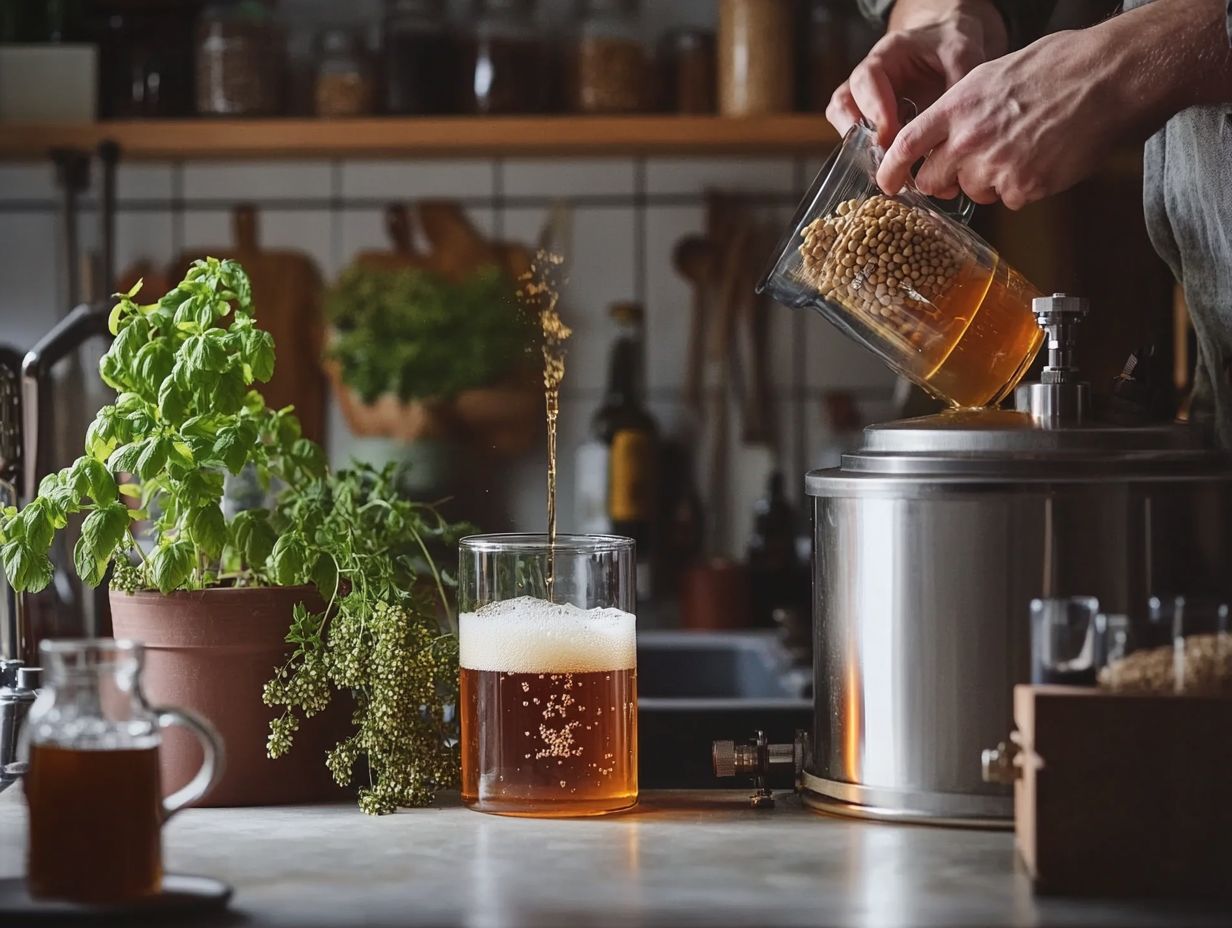
- Save money by brewing beer at home instead of buying expensive commercial beer. Joining brewing clubs can also provide additional cost benefits.
- Customize your beer to your exact taste and preferences with home brewing.
- Home brewing allows for experimentation and creativity, such as using a special type of yeast that can enhance flavors, resulting in unique and personalized beer flavors.
What Is Home Brewing?
Home brewing is a delightful and rewarding endeavor that invites you to create your own beer right in the comfort of your home, using various techniques and ingredients. This creative process opens the door for craft beer enthusiasts and homebrewers like you to explore a vast array of beer styles, from rich ales to crisp lagers, including Grodziskie. You will utilize unique brewing systems and personalized recipes tailored to your taste.
With numerous brewing kits and resources available, including those from reputable companies like Brau Supply in Canada, you can easily immerse yourself in the brewing community and embark on an exciting journey. You’ll have the opportunity to craft homemade beer that reflects your passion and creativity, possibly experimenting with compact brewing systems.
How Does Home Brewing Differ from Commercial Brewing?
Home brewing and commercial brewing differ significantly in several key areas, including scale, process, and the quality of the final product. As a homebrewer, you often create small batches of craft beer for your own enjoyment and experimentation. In contrast, commercial brewing operates on a larger scale, with production facilities that prioritize efficiency and consistency, often using advanced brewing systems.
The brewing systems in commercial settings often feature advanced technology, while you have the flexibility to employ DIY methods and equipment, allowing for greater creativity in crafting various beer styles, such as Belgian beer or an IPA.
This distinction influences the brewing techniques you use and impacts the flavor profiles and types of beers you produce. As a homebrewer, you cater to a niche audience, giving you the opportunity to express your personal tastes and experiment with unconventional ingredients that might not appeal to mass-market consumers, such as using different strains of yeast or including durable materials in your brewing equipment.
Commercial breweries must also consider market demands and customer preferences, which often results in a focus on popular beer styles.
Ultimately, both home brewing and craft brewing hold important places in the beer appreciation community. They nurture a sense of passion and creativity, whether you are indulging in a leisure activity at home or pursuing a burgeoning business endeavor. Figures like Nick Carr and Jack Horzempa have significantly contributed to this vibrant community.
What Are the Benefits of Home Brewing?
The benefits of home brewing can transform a simple pastime into an exciting adventure that enriches your skills and deepens your understanding of beer appreciation. The brewing tradition you engage with can also offer a deeper connection to the history and culture of beer brewing.
For enthusiasts like yourself, home brewing not only provides a cost-effective alternative to buying commercial craft beers but also gives you the power to customize flavors and ingredients. This allows you to craft unique, personalized brews that reflect your tastes.
Beyond the financial savings, the health advantages linked to homemade beer such as the presence of antioxidants and vitamin B often inspire individuals to embrace this brewing adventure, cultivating a stronger bond with the vibrant brewing community. This journey can enhance your overall beer knowledge, making it even more rewarding.
1. Cost Savings
One of the most compelling advantages of home brewing lies in the substantial cost savings compared to buying craft beer from commercial breweries. With the right brewing kits and access to quality ingredients, you can craft your favorite beer styles at a fraction of the price, turning this into an economically savvy hobby.
Once you cover the initial investment for a brewing kit typically including essential equipment like fermenters, bottles, and airlocks the ongoing costs become remarkably minimal. Brewing a batch of amber ale or a hoppy IPA can cost you just a few dollars per bottle, especially when you purchase ingredients like malt, hops, and yeast in bulk.
You can uncover cost-effective ingredient options by experimenting with different recipes. For example, using drier or seasonal hops can help keep your expenses in check. Over time, these savings accumulate significantly, allowing you to indulge in high-quality craft brews without putting a strain on your wallet.
2. Customization of Beer
Home brewing presents a remarkable opportunity for you to tailor your beer to your personal tastes and preferences a luxury that s often missing in commercially brewed craft beer. By hand-selecting your brewing ingredients and recipes, you can craft distinctive beer styles that truly reflect your unique flavor profile.
From choosing the type of malt to determining the hop varieties, every decision can significantly influence the final brew. You can elevate a basic recipe by experimenting with additions like fruits or spices, introducing unexpected depth and complexity. Imagine transforming a porter with the rich addition of chocolate or coffee, or infusing a pale ale with zesty citrus notes for a refreshing twist!
As a homebrewer, you ll love the satisfaction that comes from creating a brew that s uniquely yours! Every batch serves as a new lesson and an exhilarating journey toward achieving a personalized taste that aligns with your expectations. This hands-on approach deepens your connection to the craft and often results in the creation of truly unique and memorable beers that you can proudly share. Enjoy sharing your high-quality homemade beer with friends and family!
3. Experimentation and Creativity
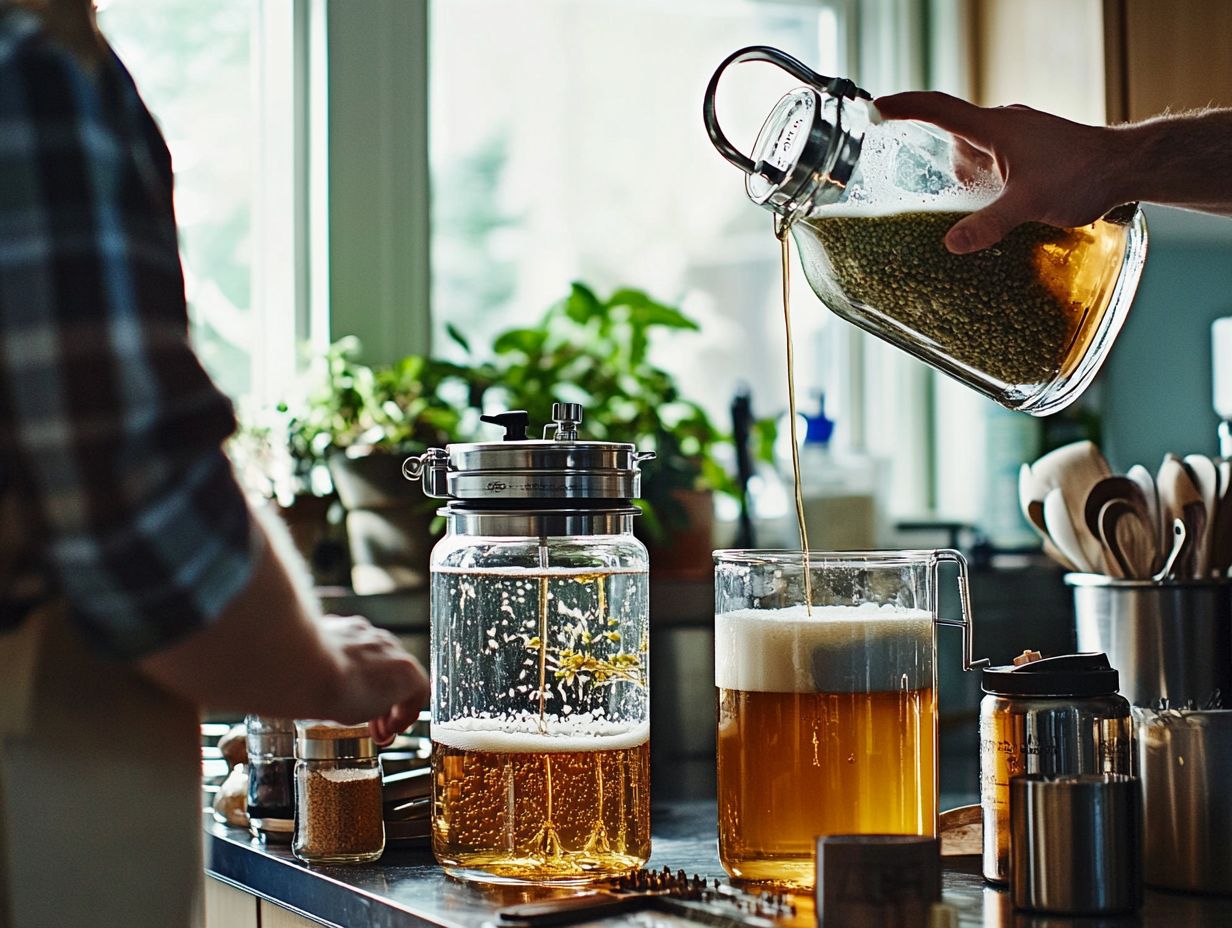
Home brewing opens up a thrilling world of experimentation and creativity. It invites you to push the boundaries of traditional brewing techniques while exploring an array of new flavors and styles.
This creative journey not only sparks innovation in craft beer but also deepens your understanding of the brewing process itself. Experimenting with various brewing techniques can lead to unexpected and delightful results.
As you dive into this experimentation, document your trials and errors. Transform each batch into a unique learning experience.
For those eager to experiment, prioritizing safety is crucial. Be diligent about sanitizing your equipment and consider starting with smaller batches when trying out new techniques.
Countless successful examples exist, from craft brewers who incorporate unconventional ingredients like fruits and spices to those who create hybrid styles that marry various brewing traditions. These experiments refine your personal brewing skills and enrich a dynamic brewing community.
Sharing your discoveries can inspire others and foster a vibrant culture of creativity and collaboration.
4. Health Benefits
Home brewing offers a range of health benefits. These benefits are especially noticeable when you compare your homemade beer to commercial options.
You might be pleased to know that homemade beer can contain higher levels of antioxidants and vitamin B. Both contribute to various health advantages when enjoyed in moderation.
Recent studies have highlighted that home brewed varieties often retain more of these beneficial compounds. This is thanks to a brewing process that is less commercialized and typically involves fewer preservatives and additives.
By using fresh ingredients like hops, malt, and various grains, you can enhance the flavor profile and pack in additional nutrients. Understanding the nutritional qualities of your beer can make the brewing experience even more fulfilling.
As a result, you can savor a beer that tastes great and supports your heart health and boosts your immune system.
Just keep in mind that while these benefits are noteworthy, they must be balanced with responsible drinking practices to steer clear of the perils of excessive alcohol consumption.
What Are the Basic Steps of Home Brewing?
The fundamental steps of home brewing guide you through a systematic process. This journey transforms simple ingredients into exquisite beer.
This process consists of several key stages, from selecting the right brewing techniques to expertly managing the fermentation process. Each step is vital in crafting a diverse range of beer styles that showcase your skill and personal preferences.
Your preparation begins with gathering the essential equipment think brew kettle, fermenter, and bottles along with crucial ingredients like malt, hops, water, and yeast.
Once your setup is ready, the brewing phase unfolds: mash the grains, boil the wort with hops, and cool it down before fermentation kicks in. During this phase, collaborating with other homebrewers can provide valuable insights.
During the fermentation process, maintaining the ideal temperature and closely monitoring the bubbles in your airlock will ensure robust yeast activity and elevate your flavor profiles.
When it comes time to bottle, meticulous sanitation is paramount to prevent contamination. The choice of bottles can significantly influence the final carbonation and presentation of your masterpiece.
This is a crucial part of the brewing process that every homebrewer must master. With patience and a keen eye for detail, you can create everything from hoppy IPAs to rich stouts, turning your brewing aspirations into a delicious reality.
The homebrew community is incredibly supportive, offering advice on everything from all-in-one brewing systems to traditional brewing techniques.
Start brewing today and taste the difference!
What Equipment Is Needed for Home Brewing?
Homebrewers often start with basic setups but soon find the need for more advanced brewing equipment to perfect their craft.
To truly immerse yourself in the art of home brewing, you’ll need a diverse array of brewing equipment to streamline the process and achieve exceptional results. Whether you’re just starting out or you’re a seasoned brewer, the right tools and brewing kits are essential for guiding you through fermentation and bottling. Companies like Brau Supply in Canada offer excellent brewing kits to get you started.
Beginning with a brewing kit is a wise choice. It typically comes equipped with key components like a kettle, essential for boiling your ingredients and extracting their rich flavors. A fermentation vessel, often crafted from glass or food-grade plastic, is crucial for allowing the yeast to work its magic and convert sugars into alcohol. For newcomers, a straightforward bucket or carboy will do just fine. More experienced brewers might prefer specialized fermenters that offer precise temperature control. Using silicon gaskets helps ensure airtight seals in your fermentation vessel.
Don t overlook the importance of bottling supplies. Grab your bottles, caps, and a capper to get your brew ready for the big reveal! Each piece of equipment you choose plays a vital role in your brewing adventure, shaping the flavor profile and fizziness of the beer you create. Embrace these essential tools, and you’re well on your way to crafting your perfect brew within the rich tradition of home brew.
What Are the Different Styles of Beer That Can Be Brewed at Home?
The brewing community is vast, offering numerous beer styles and brewing techniques to explore.
Home brewing unveils a realm of possibilities, allowing you to craft an impressive array of beer styles right in the comfort of your own kitchen. From classic ales to lagers, and from IPAs to stouts, each style offers unique characteristics and challenges. Whether it’s the complex flavors of a Dubbel or the smoky notes of a Grodziskie, there’s always something new to try.
Whether you’re drawn to classic ales, indulgent stouts, refreshing lagers, or vibrant, hoppy IPAs, the spectrum of craft beer invites you to unleash your creativity. It’s an opportunity to discover a brew that perfectly aligns with your unique taste preferences and personal flair.
1. Ales
Ales stand out as one of the most beloved beer styles among homebrewers. They rely on top-fermenting yeast that flourishes at warmer fermentation temperatures. This versatile style is bursting with flavors and aromas that will excite your palate, making ales the go-to choice for countless craft beer aficionados.
The unique characteristics of ales come from their various sub-styles, including Pale Ales, India Pale Ales (IPAs), Brown Ales, and Belgian Ales. Each sub-style showcases distinct qualities, influenced by the ingredients you choose like different malts and hops as well as the fermentation techniques you employ. For instance, a Pale Ale typically presents a harmonious balance of malt with a hoppy finish, while a Belgian Ale delights your palate with fruity and spicy notes.
Embarking on the journey of homebrewing these styles can be immensely rewarding. It all begins with selecting the right ingredients, including specialty malts and hops, and meticulously following fermentation practices to achieve your desired flavors. By skillfully controlling fermentation temperatures and timing, you can recreate the remarkable profiles that make commercially available ales so enticing.
2. Lagers
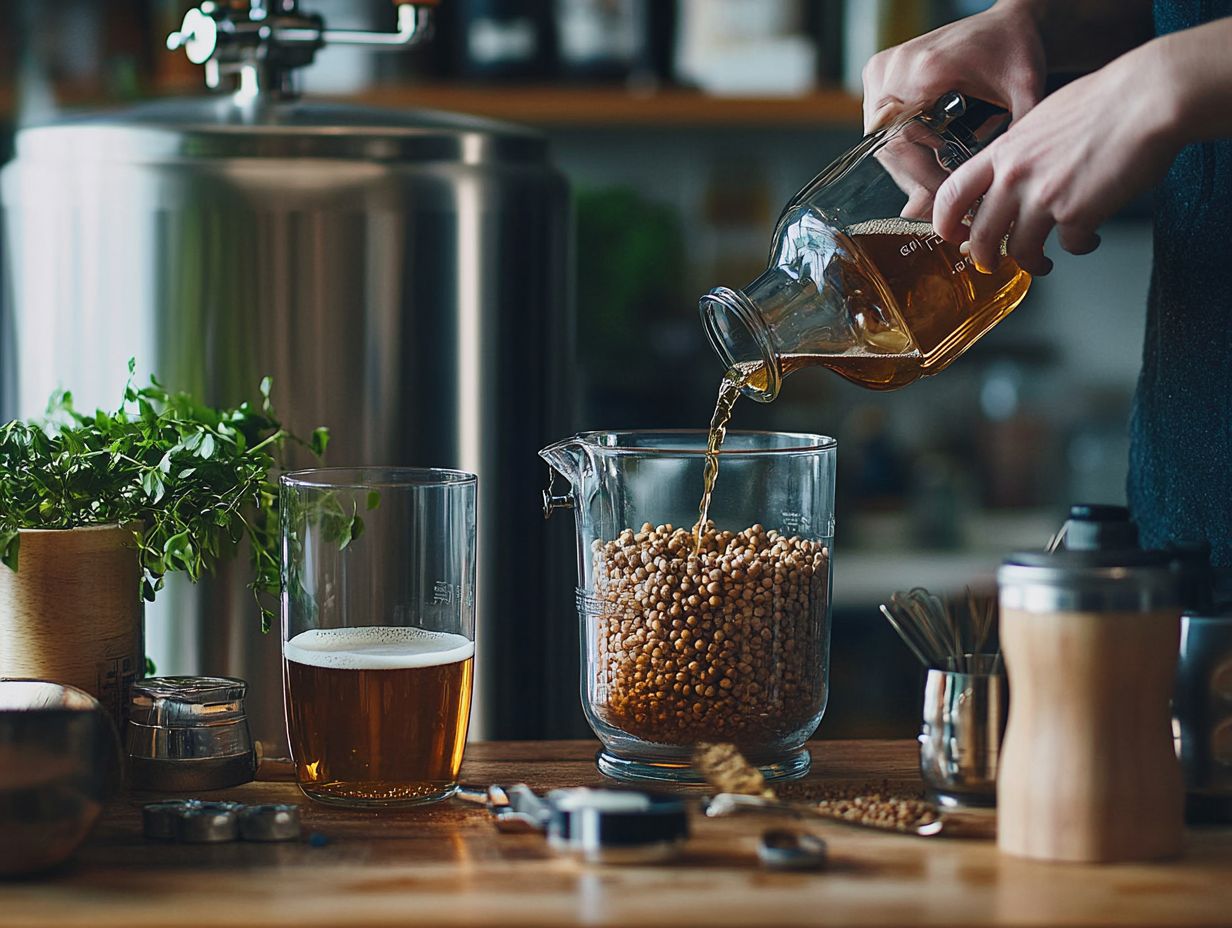
Lagers, with their clean and crisp taste, stand out as a favored choice in home brewing. They utilize bottom-fermenting yeast that flourishes at cooler fermentation temperatures. Crafting lagers often demands a bit more patience and precision compared to ales. The reward is a collection of refreshing and drinkable beers that you can be proud of.
Some popular lagers are Pilsner and M rzen, each with unique flavor profiles. To master the art of lager brewing, you’ll need to select the right yeast strain specifically those that thrive in the 45-55 F (7-13 C) range. This cooler environment is essential for developing the subtle flavor profiles that define lagers while minimizing those fruity esters that can overshadow their crispness.
In terms of notable styles, Pilsners shine with their light, hoppy character, while M rzen captivates with its malty sweetness. Both styles necessitate careful monitoring during fermentation. Conditioning, or lagering, typically lasts several weeks and is crucial for achieving that signature crispness that lagers are known for.
For aspiring home brewers like yourself, investing in temperature control and paying attention to these details can significantly elevate your lager-making prowess. Understanding the nuances of yeast strains, like the historic Kveik yeast, can add unique dimensions to your brews. So roll up your sleeves and start brewing your own lagers today!
3. Stouts and Porters
Stouts and porters are the dark knights of the beer world, offering a delightful blend of rich flavors and complex aromas that beckon to homebrewers eager to delve into malt-forward recipes. Both styles rely on roasted malts to achieve their signature colors and flavors, opening the door to an impressive variety of unique brews. These styles often attract those interested in the health benefits of antioxidants present in dark malts.
As you navigate this realm, you ll notice that stouts typically present a fuller body with a more pronounced bitterness, while porters often boast a slightly lighter texture accompanied by a subtle sweetness. Experimenting with the diverse range of malts at your disposal is essential, as this will profoundly shape your final taste profile.
Take oatmeal stouts, for example; they incorporate oats for an added creaminess that elevates the experience. On the other hand, imperial porters can surprise you with their bold alcohol content and rich, deep chocolate notes. Understanding the intricate details of ingredients and brewing techniques is crucial for creating amazing versions of each style that reflect your personal taste.
4. IPAs
India Pale Ales (IPAs) have undeniably taken the craft beer scene by storm, quickly becoming a staple among homebrewers who crave bold hop flavors and aromatic profiles. You ll find that IPAs come in a variety of styles, from the crisp and bitter West Coast IPAs to the hazy and juicy New England IPAs, each offering distinct characteristics that cater to a wide range of palates. Some famed IPAs include Pliny the Elder, known for its strong hop character.
To truly elevate your brewing game, it s essential to grasp the intricacies of the brewing process when crafting these beloved brews. Selecting the right hops is paramount, as each variety contributes its own unique aromas and flavors ranging from piney and resinous to vibrant and fruity. Many brewers like to experiment with dry hopping (adding hops after boiling to enhance aroma without bitterness), a technique that adds hops during fermentation, enhancing hop aroma without introducing any unwanted bitterness.
Striking the right balance with the malt backbone is also crucial for achieving a well-rounded flavor profile. As you embark on your homebrewing journey, take the time to consider the specific traits of the IPA style you wish to create. For instance, a West Coast IPA typically leans toward a drier finish and a clearer appearance, while a New England IPA is known for its hazy look and juicy mouthfeel.
Don’t wait start your brewing adventure today and discover your favorites!
What Are Some Tips for Successful Home Brewing?
To ensure your home brewing experience is nothing short of exceptional, consider a few key tips that can elevate the brewing process and enhance the quality of your final product. From selecting the right brewing equipment to mastering fermentation techniques, these strategies will guide both novice and seasoned homebrewers toward achieving flavorful and satisfying results.
One fundamental aspect to keep in mind is the selection of high-quality ingredients. Fresh hops and malt are essential, as they significantly influence the beer’s flavor profile. You should also pay careful attention to the temperature at which you mix your grains with water; even the slightest variations can alter the sweetness and body of your brew.
Brewing knowledge shared by experts like Nick Carr and Jack Horzempa can provide valuable insights to improve your brewing techniques.
Sanitation cannot be overlooked; diligently cleaning all your equipment before and after use is crucial to minimizing the risk of contamination that could spoil your beer. Keeping a consistent temperature in the fermentation area will help you avoid off-flavors that can arise from stressing the yeast.
Throughout your brewing journey, you may encounter challenges perhaps unexpected cloudiness or off-flavors. However, remember that consistent practices and meticulous attention to detail are your allies in achieving better results. Embrace the process, and your efforts will undoubtedly pay off in the end.
What Are the Common Mistakes to Avoid in Home Brewing?
Home brewing can be an incredibly rewarding journey, but there are some common pitfalls you should be aware of to ensure your brewing experience is nothing short of exceptional. From sanitation missteps to improper fermentation techniques, understanding these challenges will elevate your skills and help you craft high-quality beer.
Among the most frequent mistakes in the beer brewing process are failing to properly sanitize your brewing equipment, neglecting temperature control during fermentation, and not allowing enough time for your beer to age. Sanitation is of utmost importance; even a tiny bit of contamination can spoil an entire batch. The good news is that addressing these issues is often quite simple investing in a reliable sanitizer and maintaining consistent fermentation temperatures can dramatically enhance your results.
Learn from these common mistakes to enhance your brewing skills! Embracing patience in the brewing process will enable you to develop richer, more complex flavors in your final product. This mirrors the rich brewing traditions of many brewing communities. Engaging with the brewing community and sharing your experiences fosters growth; by learning from each other’s mistakes, you not only refine your skills but also build a supportive network that benefits everyone involved.
This sense of community is evident as you ll often find homebrewers gathering both online and in person, sharing tips and experiences. These gatherings can be invaluable in improving your craft.
How Can Home Brewing Be a Social Activity?
Home brewing is an exciting way to connect with others! It fosters relationships within the brewing community and elevates the overall beer appreciation experience. It also allows enthusiasts to explore different beer styles and brewing systems. Whether you find yourself in brewing clubs, attending beer tastings, or engaging in collaborative brewing sessions, home brewing offers ample opportunities for enthusiasts like you to share your passion and knowledge.
For instance, brewing clubs frequently host regular meetings where you can exchange tips, discuss brewing techniques, and critique each other’s creations. Members often share their experiences with various homebrew projects, including ales, lagers, and IPAs. Events such as local home brew competitions create a lively atmosphere for you to showcase your talents while sampling a diverse array of beers. These gatherings cultivate a sense of camaraderie, as individuals bond over their mutual love for the craft. They might also discuss their favorite types of homemade beer, such as Belgian beer or Grodziskie.
Participating in beer tastings allows you to uncover new flavors and beer styles, further enriching your own brewing endeavors. The collaborative nature of these experiences not only fosters friendships but also enhances your creativity and skill development, ultimately making your journey in home brewing even more rewarding. Some homebrewers even experiment with different yeast strains like Kveik yeast to create unique brews.
What Are Some Safety Precautions for Home Brewing?
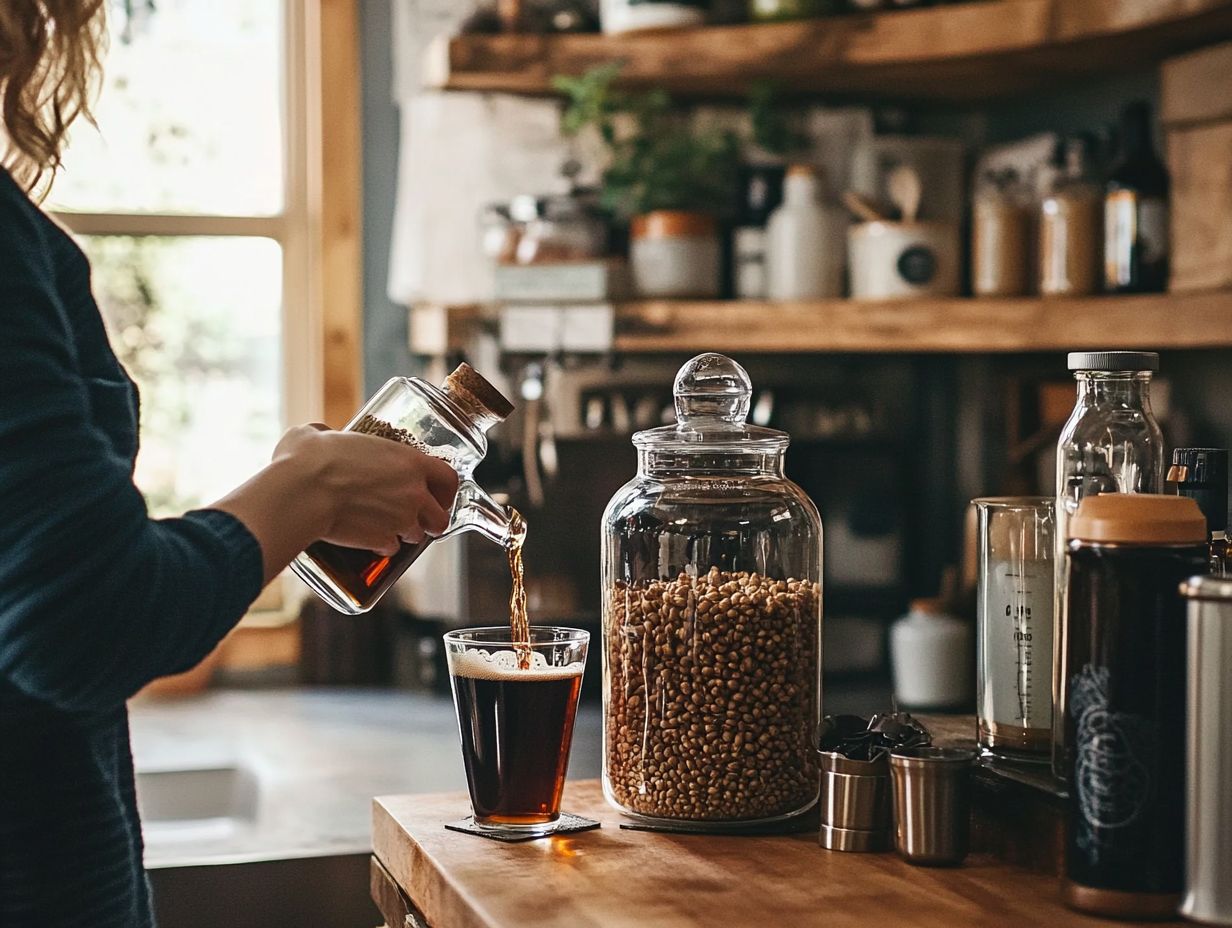
Implementing safety precautions during home brewing is essential. It ensures a safe and enjoyable experience, especially when working with brewing equipment.
Proper ventilation and using safe materials like silicone tubing can help avoid accidents. By adhering to key safety guidelines, you can minimize risks and amplify your brewing enjoyment.
This means being well-informed about the equipment you use. Ensure that all your tools are clean and in good working order to prevent any accidents.
Proper sanitation practices are crucial. Maintaining a sterile environment helps eliminate any contamination that could spoil your brew or lead to unwanted hazardous reactions. Nick Carr and Jack Horzempa, both respected in the brewing community, often stress the importance of sanitation.
You should also be mindful of potential hazards associated with fermentation. Excessive pressure build-up in sealed containers can be dangerous.
Recognizing the significance of these safety measures enhances the quality of your homebrew. It also protects you and those around you from any unexpected mishaps.
Remember, prioritizing safety can make your brewing adventure much more enjoyable and worry-free!
Frequently Asked Questions
What are the benefits of home brewing?
Home brewing allows for complete control over the ingredients and process. Fresh ingredients provide antioxidants and vitamin B, which can offer health benefits.
Is home brewing cheaper than buying beer?
Yes, home brewing can save money in the long run. The cost of ingredients is typically lower than purchasing ready-made beer.
Are there health benefits to home brewing?
Home brewing uses fresh, natural ingredients. This avoids preservatives and additives found in many commercial beers.
Can home brewing be a sustainable practice?
Yes, home brewing can reduce the carbon footprint. It eliminates transportation and packaging waste associated with store-bought beer.
What skills can be learned through home brewing?
Home brewing requires knowledge of science, math, and creativity. Understanding the fermentation process is key to mastering the craft.
What are the social benefits of home brewing?
Home brewing can bring people together to share and enjoy different beers. Joining brewing clubs or participating in events by organizations like Brau Supply in Canada can expand your beer knowledge significantly.

